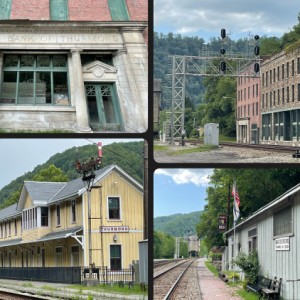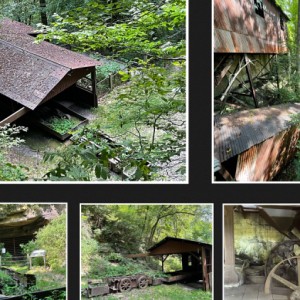Exploring New River Gorge
Thursday
Today we focused on the Fayetteville area of the gorge, first visiting the Canyon Rim visitor center to pick up some trail maps and other information, and returning to the bridge viewpoint we saw yesterday evening to see it in different light. Then we took some of the narrow winding roads down into the gorge to see the bridge from below. We hiked the Endless Wall trail as far as Diamond Point viewpoint, which offered several amazing views over the gorge, and as you can see from my thumbnail photo, you could look down and see people whitewater rafting far below.
Next, we hiked the Headhouse Trail, leading to the entrance of the former Nuttallburg coal mine and top of the coal conveyor, used to transport coal from the mine, near the top of the gorge, to the processing area at river level. Various exhibits at this site explain more about the mining process at this site ( see extra). Nuttallburg was one of almost fifty towns that sprang up along the New River in response to a growing nation's need for coal.
“In 1870, England-born entrepreneur John Nuttall saw opportunity in the coal rich New River gorge and began buying land and building infrastructure along the Keeneys Creek drainage, in anticipation of the arrival of the Chesapeake & Ohio Railway in 1873. Nuttallburg became the second mining town in the New River gorge to ship the "smokeless" coal, processed from a mineral seam hundreds of feet above the river corridor and shipped to industrial cities hundreds of miles away. Nuttallburg was a bustling mining community by the turn of the century, continuing to thrive after Nuttall's death in 1897 under the direction of his heirs.”
Production ceased in 1958 and Nuttallburg became like so many other riverside communities that rose and fell due to changes in the industry.
In 1998 the Nuttall family transferred ownership of Nuttallburg to the National Park Service. The site was inventoried, documented, and in 2005, listed on the National Register of Historic Places.
From there we drove to Thurmond, another ghost town, (see extra). During the first two decades of the 1900s, Thurmond was a classic boomtown. With the huge amounts of coal brought in from area mines, it had the largest revenue on the Chesapeake & Ohio Railway. Having many coal barons among its patrons, Thurmond's banks were the richest in the state. Fifteen passenger trains a day came through town - it’s depot serving as many as 95,000 passengers a year. The town's stores and saloons did a remarkable business, and its hotels and boarding houses were constantly overflowing. With the advent of diesel locomotives, and less coal coming in from local mines, the town began a steady decline. The many businesses closed down, and most residents moved on. According to the internet, it currently has a population of 4 people! While we were wandering around Thurmond, there was the rumbling of thunder fairly close by, and skies were beginning to look quite threatening. As we returned to the hotel the rain started
Step count: 20,718



Comments
Sign in or get an account to comment.


